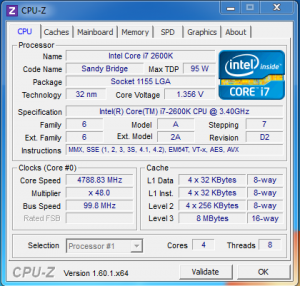 I haven’t overclocked a CPU since burning up two motherboards (of the same model) during review testing a couple years ago. Oddly enough, that particular model never made it to market. Regardless, the odor of burning electronics is not one easily removed from memory—or the room in which the burning occurred. It was traumatic enough to turn me away from overclocking for quite some time.
I haven’t overclocked a CPU since burning up two motherboards (of the same model) during review testing a couple years ago. Oddly enough, that particular model never made it to market. Regardless, the odor of burning electronics is not one easily removed from memory—or the room in which the burning occurred. It was traumatic enough to turn me away from overclocking for quite some time.
After reviewing the ECS Z77H2-A2X motherboard, a few community members lamented the lack of any mention of overclocking in our recent motherboard reviews, and honestly, I just didn’t have an excuse not to do it anymore. The Core i7 2600K is known as a very overclockable CPU. The Noctua NH-D14 heatsink is one of the best (if not the absolute best) air coolers for overclocking. Add in the most golden ECS Z77H2-A2X, which is designed to withstand conditions far harsher than the standard overclocking environment, and it basically adds up to one big conclusion: I have no choice.
Determined to re-enter the world of overclocking, I began prepping the Intel bench system with the ECS Z77H2-A2X motherboard. The overclocking configuration for the Intel system is:
- Motherboard: ECS Z77H2-A2X
- CPU: Intel Core i7 2600K
- Heatsink: Noctua NH-D14
- Thermal compound: OCZ Freeze
- RAM: 16GB (4x4GB) DDR3-1600
- SSD: OCZ Vertex 2 120GB
- OS: Windows 7 Ultimate 64-bit
Overclocking was performed with all four cores enabled. All voltage settings were left to automatic except where noted. Speeds were verified with both CPU-Z and AIDA 64. Verification of each stage of overclocking was tested with AIDA64’s stability test. Turbo Boost was turned off. RAM was configured to use XMP profile #1 (1600MHz, 11-11-11). FSB and multiplier were set manually.
I started with something easy: a 36x multiplier, which was a mere 200MHz increase. No need to rush in and burn something up (again). Settings were saved and the system was rebooted. Once Windows finished booting, I brought up CPU-Z and AIDA64 to verify the overclock…and nothing had changed. The CPU was still running at 3.4GHz. Perhaps I had forgotten to actually save the newer settings before rebooting? Nope. Returning to the BIOS showed the requested settings were 100×36 and had saved properly. They were just being ignored.
I got 99 problems, but FSB ain’t one
That’s not to say no adjustments worked whatsoever; FSB adjustments worked fine—I was able to move up to 102MHz without an issue. The multiplier caused problems though. Any downward adjustment worked fine, but upward adjustments were completely ignored (despite the BIOS reporting the requested adjustments correctly).
An e-mail conversation with ECS Tech support (along with some screen images) produced the solution: Turbo Boost had to be left turned on for overclocking to work. In my opinion this is completely the opposite of how things should work; if you’re overclocking, the last thing you want to happen is an automatic raising of CPU frequency beyond what you’ve specified. In fact, on most other motherboards this is the correct thing to do. As it turns out, ECS requires Turbo Boost to be enabled—once the multiplier is raised beyond stock, the additional 4-3-2-1 core frequency adjustments are completely disabled. Oh, and this isn’t mentioned anywhere in the manual either.
With that mystery solved, the overclocking commenced. Sure enough, Windows booted up, and both CPU-Z and AIDA64 reported a frequency of 3.6GHz. Voltage was being adjusted automatically by the motherboard as speeds were increased.
At 4.6GHz it was evident that stability was being affected, so the CPU PLL Voltage was increased 0.020V above default, and things became stable again. Moving on, 5.0 GHz proved to be a bit too much as Windows would blue screen during various stages of booting. The maximum stable overclock for my first overclock in quite some time was an impressive 4788.83MHz (from this point on, it’ll be approximated to 4.8GHz).
Does the extra speed make a difference? You’d better believe it. At the stock 3.4GHz, Handbrake transcoded a Blu-ray to H.264 at 99fps. Overclocked to 4.8GHz, that number jumped to 132fps. It’s not quite a 1:1 gain, but there are two factors, storage speed and a less-than-full CPU load, that are the likely causes. The video source material was stored on a 7200RPM hard drive and might not have been fast enough to continually feed Handbrake, and the hyperthreaded CPU didn’t always have a 100% load. Regardless of the reasons, this is an impressive gain in performance.
Naturally, temperatures increased as well. Under load, stock clock speeds topped out at 36C. Overclocked, the same load resulted in maximum temperatures of 73C. This is still well within Intel’s specifications, but you’ll want to have some excellent cooling at these speeds—again, the Noctua NH-D14 allows for some great overclocking. The stock cooler certainly wouldn’t be up to the task.
And there it is, my first overclock in a long time, and I’d say it was a resounding success. The ECS Z77H2-A2X is an excellent motherboard for overclocking. The only problem I had was the Turbo Boost setting. Other than that it was smooth sailing. If you’re looking for a good motherboard for overclocking I’d definitely recommend the ECS Z77H2-A2X. It handles overclocking like a champ.







 Articles RSS
Articles RSS